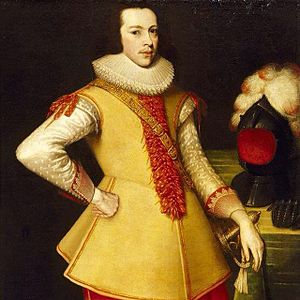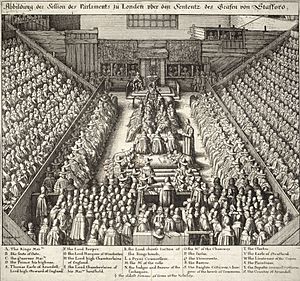Sir Alexander Carew, 2nd Baronet facts for kids
Quick facts for kids
Sir Alexander Carew
|
|
|---|---|

Sir Alexander Carew
|
|
| Governor of St Nicholas' Island, Plymouth | |
| In office 1642 – August 1643 |
|
| Member of Parliament for Cornwall |
|
| In office November 1640 – September 1643 (suspended) |
|
| Personal details | |
| Born | 30 August 1609 Antony, Cornwall |
| Died | 23 December 1644 (aged 35) Tower Hill |
| Cause of death | Executed for treason |
| Resting place | St Augustine's, Hackney |
| Nationality | English |
| Spouse | Jane Rolle (1606–1679) |
| Relations | John Carew; James Chudleigh; |
| Children | Sir John Carew; Richard (1641-1691) Joan (?-1716); Mary; Bridget |
| Parents | Bridget Chudleigh (ca 1584–1612); Sir Richard Carew (1580–1643) |
| Occupation | Landowner, soldier and politician |
| Military service | |
| Allegiance | |
| Battles/wars | First English Civil War |
Sir Alexander Carew (born August 30, 1608 – died December 23, 1644) was an important English landowner, soldier, and politician. He came from a place called Antony, Cornwall. In November 1640, he was chosen to be a Member of Parliament (MP) for Cornwall.
During his time as an MP, he voted for a very serious decision: to put the Earl of Strafford to death in May 1641. He also wanted to change the Church of England by removing bishops from their powerful positions.
When the First English Civil War started in August 1642, Sir Alexander Carew was one of the few wealthy people in Cornwall who supported Parliament. In March 1643, he became the commander of St Nicholas' Island. This island was a very important place for defending the city of Plymouth.
However, in August 1643, he was arrested because he tried to switch sides and join the King's supporters. He was taken to London. To show how serious they were about winning the war, Parliament decided to put him to death for treason in December 1644. Other important people, like Sir John Hotham and Archbishop Laud, were also put to death around the same time. Sir Alexander's half-brother, John Carew, was also executed later in 1660 for his role in the death of King Charles I.
About Alexander Carew's Family
Alexander Carew was born on August 30, 1608. He was the oldest son of Sir Richard Carew, 1st Baronet (born around 1580 – died 1643) and his first wife, Bridget Chudleigh (born around 1584 – died 1612).
In 1621, his father, Sir Richard, got married again to Grace Rolle. They had four sons together. One of these sons was John Carew. John later signed the order that led to the death of King Charles I. Because of this, John was also put to death in October 1660.
Alexander's father, Richard Carew, was a moderate Puritan. This meant he had strong religious beliefs but was not extreme. He was very interested in learning, inventing new things, and even breeding cats! In August 1641, he bought a special title called a baronetcy. King Charles I sold these titles to raise money.
In 1631, Alexander married Jane Rolle (born 1606 – died 1679). They had five children who grew up to be adults: Bridget, Mary, Joan, John, and Richard.
Alexander Carew's Public Life

We don't know which university Alexander Carew went to. But in 1628, he joined the Middle Temple. This was a place where people learned about law, which was an important part of a gentleman's education back then.
Just like his father and grandfather before him, Carew was elected as a Member of Parliament for Cornwall in November 1640. This Parliament was known as the Long Parliament. He strongly supported removing bishops from the Church of England. He also voted for the execution of the Earl of Strafford in May 1641. He was even quoted saying that he would agree to the execution even if he knew he would be next to suffer the same fate.
When the First English Civil War began in August 1642, Carew was one of the few wealthy landowners in Cornwall who openly supported Parliament. Because of his support, he was appointed to many important committees.
After his father passed away in March 1643, Alexander became a member of the Cornish Sequestration Committee. He also became the commander of St Nicholas' Island. This island was a key defensive spot for the city of Plymouth.
Many people who went to war in 1642 thought it would be over quickly with one big battle. But by 1643, it was clear the war would last longer. Parliament's supporters, like Carew, whose lands were in areas controlled by the King's side, faced financial problems.
Turning Points and Trouble
The summer of 1643 was a very successful time for the King's supporters, called Royalists. By August, they controlled almost all of the West Country, except for Plymouth and Exeter.
Carew's cousin, James Chudleigh, who led Parliament's forces in Devon, switched sides after being captured in May. Alexander Carew himself then started talking about switching sides too. In August, he ordered his soldiers to fire on a Parliamentarian warship entering the harbor. But his soldiers refused to obey his order. It is said that he only avoided being attacked by his own men because the ship's captain stepped in to help him.
Because he was accused of treason (betraying his side), Carew was held in the Tower of London. He was also removed from Parliament. As the war became more intense, both sides started using military law to punish high-ranking officers who had changed their loyalty.
In August 1644, Parliament set up a special military court to try people suspected of betrayal. In November, Carew was sentenced to death. The former commander of Hull, Sir John Hotham, and his son were also sentenced to death. Leaders like Oliver Cromwell supported these sentences. They felt that the war might be lost if people were not fully committed.
Carew's wife asked Parliament to spare him. She claimed he was "in a kind of distracted condition and unfit to die." Parliament did not agree with her claim, but they gave him one month to get his affairs in order.
He was put to death on Tower Hill in December 1644. The Hothams and Archbishop Laud were executed in January. Archbishop Laud had been held since 1641, and many believed he was executed to please the Scottish Covenanters. Carew was buried in the graveyard next to St Augustine's Tower, Hackney.
Even after his execution and his half-brother's execution in 1660, his family's social standing did not seem to be affected. His son John inherited his title and lands. Both John and his brother Richard served as Members of Parliament. Of his three sisters, Mary married John Sparke, who was an MP for Plymouth. Joan married Walter Kendall, an MP for Lostwithiel. Bridget's husband was John Pendarves. Their son, Alexander, was also an MP from 1689 to 1725.
|


